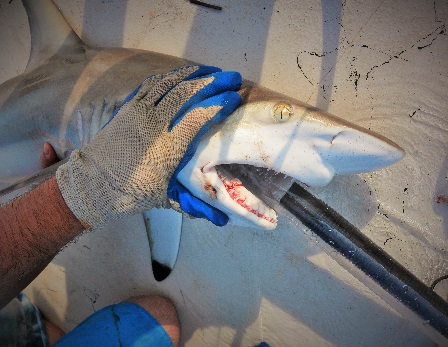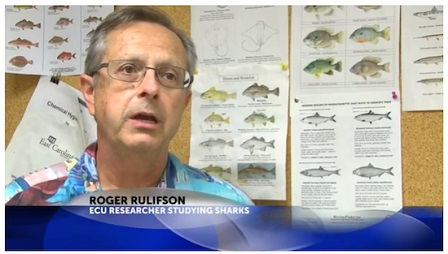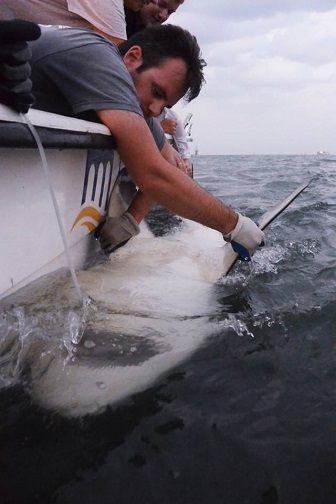By REBECCA NAGY
Rebecca Nagy is a communications intern with North Carolina Sea Grant. She graduated from North Carolina State University with a degree in English and a minor in environmental science.
In a typical year, one or two shark bites are reported in North Carolina. This summer, the relatively high number of shark bites has caused North Carolina beaches to become the center of media attention, from the local to global scale.
In June and July, eight people, ranging in age from 8 to 68, suffered shark-related injuries. Kiersten Yow, 12, is one of two teens who lost part of their arms in separate incidents. Follow the North Carolina native’s recovery on www.facebook.com/KierstenYowSupport.
With this spotlight on the state, shark researchers from North Carolina have had countless media interviews to provide their insight and research results — and to ease the minds of the public in regards to these high-profile ocean inhabitants. Here are a few snapshots of the coverage.
INCREASE IN ACTIVITY
This has not been a typical year shark-wise in North Carolina, Chuck Bangley, doctoral candidate at East Carolina University, told The Associated Press in a story and video that went nationwide.
“It’s a highly unusual situation. Typically, North Carolina gets an average of about one or two shark bites per year.”
While there have been more incidents so far in 2015, Bangley told “My Carolina Today” on WNCN in Raleigh in a live interview, that this does not mean there are more sharks in the water.
“North Carolina is a hot spot for sharks. It’s actually a mixing area between two major marine ecosystems. So there is a lot of food available to sharks.”

Researchers insert a hose into the mouth of a juvenile blacktip shark to keep water flowing over its gills. Photo by Cecilia Krahforst.
Roger Rulifson, a researcher at East Carolina University, agrees. “We don’t quite understand what is going on. It is quite unusual,” he said in an interview with The Columbus Dispatch for a travel section story. Many Ohioans visit the North Carolina coast.
The Rulifson lab at ECU has conducted shark research for nearly 20 years. Bangley, a student in the coastal resource management program at ECU, is advised by Rulifson. North Carolina Sea Grant has funded multiple shark research projects for the lab.
This unusual summer has led them and other researchers to consider potential explanations for the bites. “It’s probably a number of factors — some of which involve the ecology of the coastal ocean, some of which involve people’s behavior,” explains Joel Fodrie of the University of North Carolina at Chapel Hill’s Institute of Marine Sciences in a UNC-TV interview on “North Carolina Science Now.”
“Anybody who has flown the coast in the last couple of decades has probably seen sharks along the beaches, sometimes in close proximity to people,” Fodrie continued.
However, a majority of the time, those sharks do not identify humans as food. “There’s a very rare set of circumstances — maybe when the water is very turbid, and there’s lots of bait in the water, and the water is noisy with wave action — that the shark is not able to discern one prey item from the other,” Fodrie added.
SEEKING ANSWERS
Bangley shared similar thoughts with Rachel Lewis Hillburn, host of the live “Coastline” program on WHQR in Wilmington. “The heat wave that we had in mid-June happened to coincide with when everybody got out for summer vacation,” he explained.
With the rise in temperature came an increase in the number of beach visitors. “On top of that, we have an annual migration of marine species that occurs in North Carolina from about May to June,” he continued. This migration is not limited to sharks. Sea turtles, schools of menhaden, large fish and some marine mammals make the trip north as well.

In an interview with the Greenville ABC affiliate WNCT, Roger Rulifson offers shark safety tips. Photo courtesy WNCT.
Rulifson agrees with this theory. When he spoke to Asia One, he explained why this year’s migration may have been influenced by the weather.
“The sudden increased water temperatures early in the summer could have caused a mass migration of sharks rather than migrations northwards in waves. If true, then this would cause the sharks to spread out, even going into shallow waters, in search of food,” he said.
Breeding activities also may be a reason more sharks are nearer to shore. “This is the time of year when a number of these sharks come in to pup, or spawn,” Rulifson told AP in another story that was picked up by media nationally. “So it’s very possible that’s one reason they might be close to shore.”
SEA GRANT STUDIES
Bangley’s current research involves catching, tagging and releasing sharks in an effort to understand their habitat and breeding habits. He explained shark activity to WHQR.
“In Pamlico Sound, we have six main species … dominated by the smooth dogfish, which is a small shark that’s really no threat to people. They mostly eat shrimps and crabs,” he said. There also are black tip, sandbar and bull sharks, which range the farthest up the sound, he added.
Bangley has a particular research interest in bull sharks, which he believes may be the species responsible for some of the bites this year.
He explained his Sea Grant-funded research on bull shark nurseries to The News & Observer of Raleigh, in the debut of its daily “Focus” section in July.
“By combing through bycatch data collected by the N.C. Division of Marine Fisheries, Bangley found that baby and juvenile bull sharks have been increasingly caught in Pamlico Sound since about 2010,” The N&O reported.
Although bull sharks always have been found in Pamlico Sound, their preferred nursery habitat traditionally has been located farther south. Now, higher temperatures in North Carolina waters may make it an even more desirable nursery habitat for bull sharks.

Chuck Bangley and his team caught this bull shark, measuring 8.5 feet long. Photo by Cecilia Krahforst.
Bangley also told WRAL in Raleigh that between 1969 and 2011, only nine juvenile bull sharks were found in Pamlico Sound, but 50 young bull sharks have been documented in the past four years. This coincides with a 4-degree temperature increase in the past decade.
Temperature is not the only factor that bull sharks consider when choosing a nursery.
“Bull sharks like a more specific set of nursery habitat characteristics than other sharks,” Bangley noted in an interview. “They like warm water, highly variable salinity including high freshwater inflow, and limited access to the ocean — such as the three small inlets connecting Pamlico Sound to the ocean.”
According to Bangley, bull sharks typically are found in the lower-salinity parts of the estuary to avoid competition from other juvenile species of sharks. “In Pamlico Sound, juvenile bull sharks can be found along the western shore and at the mouths of the Pamlico and Neuse rivers,” Bangley adds.
Other sharks that use Pamlico Sound as a nursery habitat include smooth dogfish, sandbar sharks, Atlantic sharpnose sharks and blacktip sharks.
However, the presence of a bull shark nursery is good news for the environment.
“The fact that bull sharks are pupping in North Carolina suggests the waters are clean, there’s an abundant food source for them and there’s plenty of habitat,” he told WRAL.
On a research trip to Harkers Island with WNCT from Greenville aboard, he told reporters that he primarily finds juvenile sharks, which usually measure no more than 2 feet.
On that day, Bangley caught a male bull shark, measuring more than 8.5 feet long. The team did not expect to find a large adult shark and did not have the equipment to tag it.
Bangley’s current work focuses on fine-scale habitat use by sharks. He tags small to mid-size sharks — usually measuring 3 to 6 feet — and picks them up on receivers placed in different habitat types.
Bangley also records their preference for seagrass or sand flat habitats, and the sharks’ distance from the nearest inlet. The target species for tagging are blacktip, bonnethead, blacknose and bull sharks. This project is supported by a Sea Grant minigrant.
“Now that we know we can get larger, apex predator-sized sharks, we’ll be building drumlines to catch them and hope to tag some of them as well,” Bangley notes. “The goal with that is to find whether they interact with the mid-sized sharks or displace smaller sharks from certain areas.”
TRADITION OF RESEARCH
The UNC-CH Institute of Marine Sciences has a long history of shark research, started in the 1970s by Frank Schwartz. Fodrie cited this long-term data in the interview with UNC-TV.
The 40-year survey shows there has not been a large increase in sharks this year, Fodrie noted. While the total number of sharks in North Carolina may have stayed the same, it is possible their distribution patterns shifted.

Joel Fodrie appears on “North Carolina Science Now” to discuss possible explanations for shark bites in the state. Photo courtesy UNC-TV.
“We’ve certainly had a very active month,” Fodrie said. But even this year’s record still is a low number when trying to detect a pattern.
“Two years ago, we had one attack. Three years ago we had two attacks,” Fodrie told Outside Online. “With as many people as we have spending time in the water, that’s amazing.”
Changes in salinity have been cited as a possible explanation for the increase in bites. However, Fodrie disagrees.
“Our data would suggest that the beaches are salty every year,” Fodrie told UNC-TV. “And they are salty this year.” A change in salinity would cause sharks to move farther up the estuaries, but he does not think it is a factor for sharks being near the beaches.
“People should not be surprised that these attacks happen in 3 feet of water near shore. Sharks have been venturing into those waters for a long time,” he explained.
Factors such as wind, currents and presence of fish such as small bait fishes, menhaden or mullet, are more likely to draw sharks near shore.
“Everybody probably needs to pay attention to their surroundings a bit more carefully. If you see a lot of signs of biological activity — bait being fed upon, a lot of people fishing in the area — it makes sense to avoid those things,” Fodrie noted to UNC-TV.
KEEPING SAFE
George Burgess, director of the Florida Program for Shark Research and the International Shark Attack file, spoke with Hilburn and Bangley on “Coastline.”
“When you enter the sea, you are entering the wilderness,” Burgess said. “We are ecotourists.”
Fortunately, there are several precautions beachgoers can take, as Burgess and other experts noted in the popular Shark Sense brochure produced by Sea Grant.
Swimmers should avoid wearing items such as “a bright shiny ring, or watch or a necklace,” Rulifson explained to WNCT. The shine of jewelry could appear like fish scales, leading the shark to mistake humans for prey.
Time of day also could be a factor in avoiding shark bites. “Sharks are very active during sunrise and sunset,” Bangley told “My Carolina Today.” Their eyesight is attuned to lighting associated with dawn and dusk.
“Generally you want to stay clear of our fishing piers in North Carolina. They can be a real attraction for sharks,” Bangley added.
Fodrie stressed that although beachgoers are safe overall, there always is a chance of interactions with sharks. “There is no sure thing — just ways to shift the balance ever so slightly in your favor by using your senses to observe what is around you and make safer decisions,” he said.
Despite the attention paid to sharks this summer, they are not the greatest threat to beachgoers.
“You stand a better chance of getting into a car wreck on the way to the beach than you do being bitten by a shark at the beach,” Rulifson told WNCT.
“Folks have a very broad interest in sharks, and rightly so, because they can be dangerous,” said Scott Baker, Sea Grant fisheries specialist, in an interview with WHQR. “But there are many other risks in the ocean that folks should be concerned about, like rip currents and general water safety.”
To learn more about North Carolina Sea Grant shark research, visit ncseagrant.ncsu.edu/sharks.
This article was published in the Autumn 2015 issue of Coastwatch.
For contact information and reprint requests, visit ncseagrant.ncsu.edu/coastwatch/contact/.
